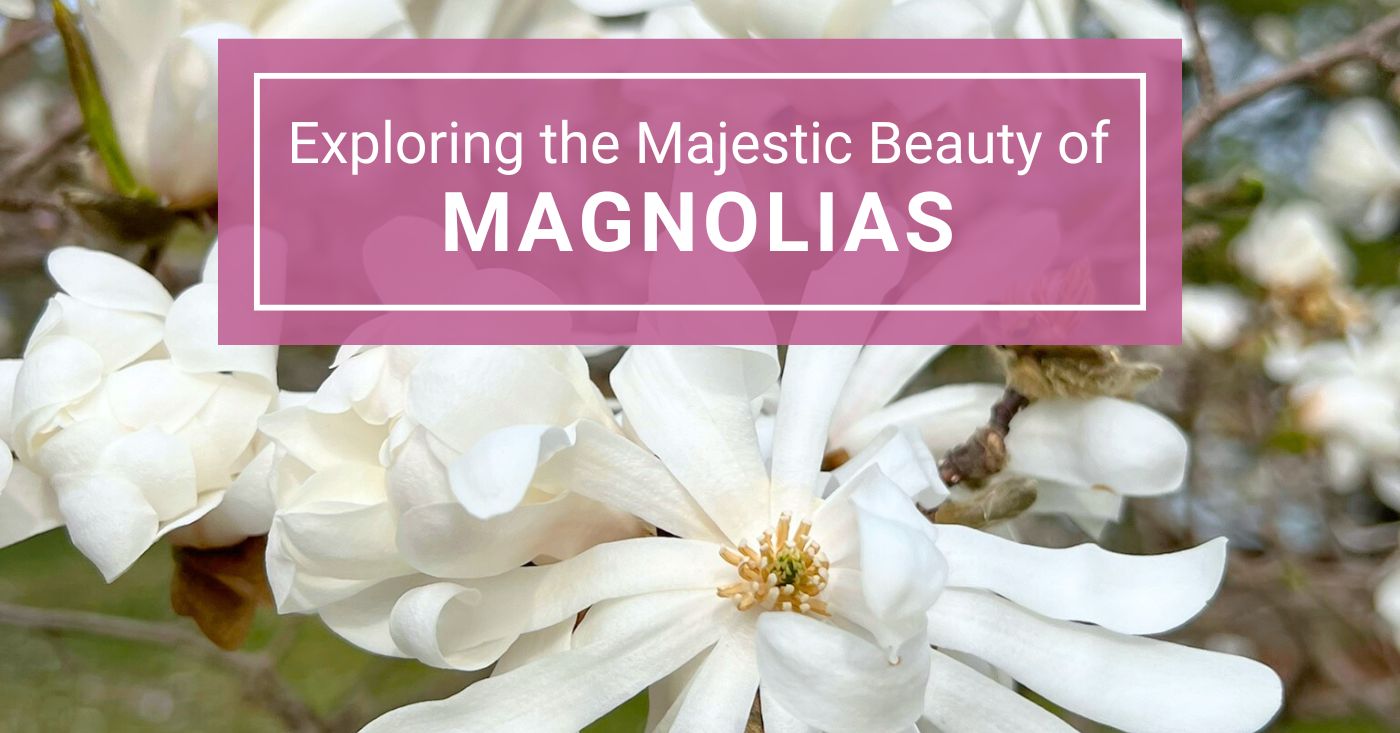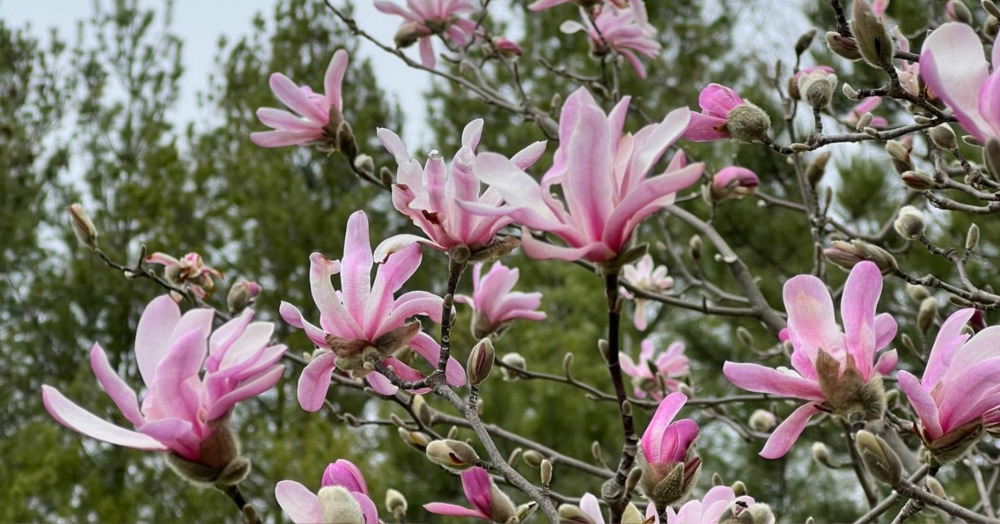Introduction to Magnolia Flowers
What blooming tree is older than our friendly pollinator bees, and lived at the same time as feathered dinosaurs? You might be surprised to learn it’s the magnolia. Fossils discovered put the genus around for more than 100 million years! The main pollinator at that time wasn’t bees or butterflies, which is why magnolias rely on beetles for pollination.
As far as the blooms go, magnolias are known for their stunning display of spring blooms. They thrive in many growing conditions, and have blooms ranging in colors from white, pink, purple, and yellow. They generally have large glossy leaves, and smooth bark that has a silver sheen to it. More than 200 species belong to the genus magnolia.
While magnolia trees are native to North and South America, they are also native to the Himalayan region, as well as East Asia. In Chinese culture, magnolias symbolize nobility and purity, while in Japan it represents dignity and perseverance. In the southern U.S. magnolia flowers symbolize luck. Worldwide, they are prized ornamental trees known for their unique, fragrant blooms, which attract pollinators, and seeds which are eaten by birds and small mammals.
Now that you know the historical significance of these amazing plants, read on for more information on how to plant and care for these spectacular trees.
Varieties of Magnolia Flowers
Like most plant genus, magnolias feature diverse varieties, including both evergreen and deciduous varieties that can tolerate diverse growing conditions. Most magnolias thrive between growing zones 4-9, with eight unique varieties being native to the U.S, including the popular southern magnolia (magnolia grandiflora). If you don’t know your growing zone, check out this interactive map.
Below is a breakdown of the popular varieties commonly found in the U.S.
Southern Magnolia (magnolia grandiflora) - The first on our list is the magnificent southern magnolia. As the name suggests, this magnolia is native to the southern U.S. in growing zones 7-9. These spectacular magnolia trees grow to heights upwards of 60 - 80 feet, making them a stunning specimen tree in the yard. They are an evergreen magnolia with large glossy leaves, meaning they do not drop their leaves annually. Big, showy white blossoms appear mid-summer to early fall. This tree can grow in full sun, but prefers part shade to thrive. Fun fact: the fragrant white flowers of this tree are recognized as the state flower of Mississippi and Louisiana!
Sweetbay Magnolia (magnolia virginiana) - Another mainly evergreen variety, with creamy white flowers flowers similar in appearance to those of the southern magnolia, the sweetbay is native to the eastern U.S. It can grow between 10-35 feet tall, and thrives in zones 5-10. If grown in cooler locations, the sweetbay adapts by being deciduous and more shrub-like in nature. In warmer climates, it will remain evergreen and grow into an upright tree. Sweetbay is also sometimes called the swamp magnolia, or the beaver tree.
Star Magnolia (magnolia stellata) - This deciduous magnolia is native to Japan, and in the U.S. grows well in zones 4-8. It can be grown as either a small tree or a large shrub, typically only reaching heights of 15-20 feet. The star-shaped flowers are white and emerge from pussy-willow-like buds in early spring. They’re known for being one of the earliest blooming deciduous plants!
Saucer Magnolia (magnolia soulangeana) - Enter the most commonly-grown magnolia in the U.S. The saucer magnolia can be grown as a large shrub or small tree, depending on pruning. The blooms are typically white, but purple flowers can also be found, based on the cultivar. It’s hardy from zones 5-9, and can grow between 20-25 feet in height. The saucer magnolia is a hybrid, a cross between a lily magnolia and Yulan magnolia.
Loebner Magnolia (magnolia x loebneri) - The loebner magnolia is fast-growing, reaching heights between 20-30 ft tall. It’s an incredibly hardy plant that can survive harsh northern zone 4 through the hot summers of zone 9. It is a hybrid plant, so it has no natural native environment. Fragrant white and pink flowers emerge in early spring. If you’re looking for a loebner magnolia, check out our Merrill Magnolia variety!
Magnolias are popular across the U.S. If you’re in the market for one, but want to see the different varieties in person, check out your local garden center or botanical garden.
Cultivation and Care of Magnolia Flowers
Planting Season
Spring and fall are the best times to plant magnolias. These seasons have less extreme temperature fluctuations, and there is more natural moisture in the soil. These will allow your plant to establish roots quicker, without trying to survive the extreme heat of summer or bitter cold of winter. Most magnolias will bloom in their first year after being planted!
Care for Magnolia Flowers
Most magnolias prefer a spot that gets full sun to partial shade, with the exception of warmer climates, in which magnolias would benefit slightly more shade.
These flowering trees and shrubs thrive in soil that is well-drained and slightly acidic, however they still grow well in neutral and poorly draining soils. If you’re unsure what pH your soil is, you can look into test strips or a pH meter.
Magnolias should be watered consistently the first season after planting, but after becoming established don’t need as much water. The more well-established the plant is, the more drought-tolerant it will become.
Challenges in Growing Magnolia Flowers
Common Diseases
Magnolias, like all garden plants, can occasionally get diseases. These diseases include leaf spot, wood rot, root rot, verticillium wilt, and magnolia scale. If you’re concerned about any potential diseases, talk to your local garden center, or university extension, which may offer horticultural advice. If your magnolia does have a pest infestation or disease, ask for organic, non-toxic treatments that are safe for your family and pets.
Deer-Resistance
If deer are a concern where you live, you might want to look into the deer-resistant varieties of magnolia such as the star magnolia and the loebner magnolia. Just because a plant is deer-resistant, however, doesn’t mean it’s deer-proof. A starving deer will eat anything to survive.
There are a few methods that can help you keep deer away from your beloved garden plants. Wrapping the trunk of the tree in wire could prevent deer from rubbing or having a snack. You could also try a natural repellent, which deters deer based on taste and/or smell. Consult with your local garden center if you have questions on natural repellents.
Uses of the Magnolia Flower
Edibility and Medicinal Uses
We mentioned the cultural significance of the magnolia species earlier, but now we would like to mention the culinary significance. Did you know that most magnolia blossoms are edible? Look up a variety beforehand, as some are not well-researched, but the petals from these flowering plants can make an excellent addition to teas or salads. Petals can also be pickled or dried and used as a spice.
Many parts of the magnolia tree were also used in traditional Chinese medicine. The bark, seed cones, flower buds, and leaves were all thought to have beneficial uses, with little negative side effects. Magnolia is used in reducing anxiety and depression, as well as for preventing gingivitis and cavities in the mouth. There isn’t enough scientific evidence to back up these claims, so if you would like to pursue the medicinal effects of magnolia, please consult your physician, and again, make sure to research the particular variety to make sure it’s edible.
Conclusion
In this guide, we discussed the history and uses of magnolia, as well as covered the popular varieties and care information. If you’re in a warmer climate looking for a towering magnolia tree, then southern magnolias might be for you. If you love cup shaped flowers, then the saucer magnolia might be more your style. No matter your taste or growing zone in the U.S., there is a magnolia species to suit your needs!
Contact us with any questions you may have, and check our Green Tips page for additional plant guides!


